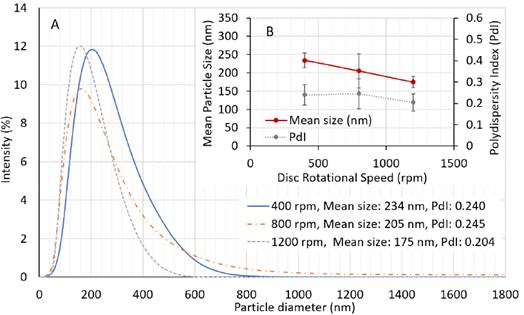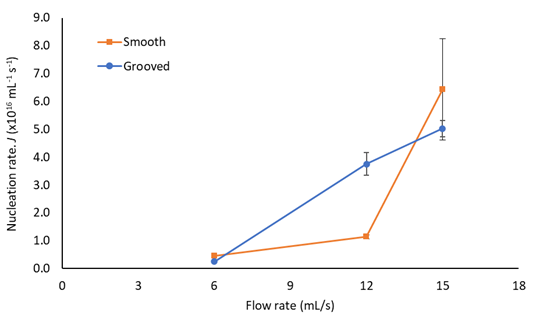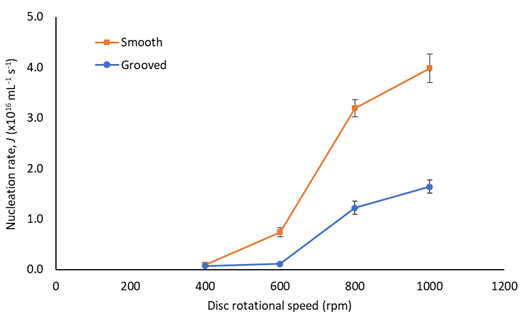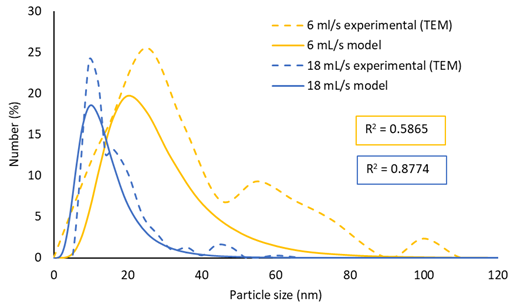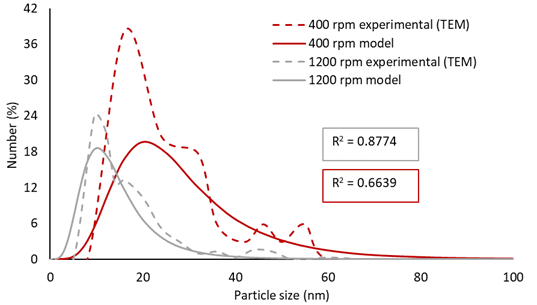(25b) Anti-Solvent Precipitation in a Continuous Flow Spinning Disk Reactor: A Route to Nanoparticles Via High Intensity Micromixing
AIChE Spring Meeting and Global Congress on Process Safety
2021
2021 AIChE Virtual Spring Meeting and 17th Global Congress on Process Safety
Topical C: Process Intensification
Advanced Process Concepts - Reactors and Reactive Separation
Tuesday, April 20, 2021 - 11:15am to 11:45am
Anti-solvent precipitation in a continuous flow spinning disk reactor: A route to nanoparticles via high intensity micromixing
S. Sana, V. Zivkovic and K.Boodhoo*
School of Engineering, Merz Court, Newcastle University, Newcastle Upon Tyne, UK
*Corresponding/presenting author (kamelia.boodhoo@newcastle.ac.uk)
Nanoparticles are increasingly being developed for application in the pharmaceutical industry, more specifically in drug delivery. Starch nanoparticles have a number of industrial applications including polymer drug carrier. The present work investigates the precipitation of starch nanoparticles by contacting starch dissolved in sodium hydroxide with an ethanol antisolvent, in a spinning disc reactor (SDR). The spinning disc reactor uses surface rotation to produce extremely thin liquid film, within which improved micromixing can occur. The SDR also benefits from reduced residence times and near plug-flow characteristics. Such properties would be advantageous to solvent-antisolvent precipitation processes, were mixing is fundamental. The interactions of the disc surface topography (grooved and smooth) with conditions such as liquid flowrate, solvent-antisolvent ratio and disc speed are likely to impact on the hydrodynamics of the thin film flow. One of the objectives of this study is also to highlight and understand such interactions on the mixing and precipitation processes.
Various hydrodynamic conditions on a 30 cm diameter disc were tested in the mixing of a starch solution in 1M NaOH solvent stream with ethanol antisolvent, injected separately at different flow ratios between 1:1 and 1:9 respectively onto the centre of the rotating disc. Particle size and distribution of starch nanoparticles generated were measured via dynamic light scattering in a Malvern Nanosizer and by TEM.
The effect of disc rotational speed on the size and particle size distribution (PSD) of starch nanoparticles is displayed in Figure 1. An increase in disc rotational speed from 400 rpm to 1200 rpm leads to a decrease in mean particle size from 234 to 175 nm, with narrower PSDs. This is attributed to increased shear generating surface waves and greater instabilities within the liquid film, enhancing mixing as the liquid travels outwards on the disc surface. Similar results have been obtained for increased flow rates from 6 mL/s to 18mL/s (248 to 175 nm). Increasing the antisolvent to solvent ratio from 1:1 to 9:1 also led to a reduction in size (276 to 175 nm), as greater supersaturation was generated at reduced solubilities, causing nucleation to dominate over particle growth. The disc texture did not demonstrate a substantial impact on nanoparticle size; however, particles produced on the grooved disc were generally of narrower PSD with higher yields.
Induction times and nucleation rates have also been experimentally determined visually using a high speed video camera. Nucleation rates increased with an increase in disc rotational speed and flow rate (Figures 2 and 3) but was found to be less dependent on antisolvent to solvent ratio. A maximum nucleation rate of 6.44x1016 mL-1 s-1 has been estimated at conditions of 1200 rpm, 9:1 ratio and 15 mL/s, on a smooth rotating disc, whereas a maximum nucleation rate of 5.03x1016 mL-1 s-1 was achieved on the grooved disc for similar hydrodynamic conditions. The advantage of the grooved disc was demonstrated at conditions of low shear rates (i.e at low flow rate and disc speed) by higher nucleation rates compared to the smooth disc, highlighting the passive mixing induced via the presence of flow disrupting grooves.
Experimentally obtained nucleation kinetics along with growth kinetics have been applied to formulate a predictive mathematical model. The model combines the population balance equations (PBEs) with an engulfment micromixing model. The Hounslow’s discretisation model which accounts for nucleation, growth, and agglomeration, has been applied to solve the PBEs and generate predictive PSDs. Figure 4 compares the modelled PSD for two different flow rates with experimental PSDs, overall showing a good agreement between the two PSDs. However the model does not account for film breakdown likely to occur at the low flow rate, causing the slight difference between the two PSDs. Figure 5 compares modelled vs experimental PSD at 400 and 1200 rpm. There is a good fit at 1200 rpm whilst the discrepancy at 400 rpm could be the due to the assumption of size-independent growth.
This study, being the first comprehensive experimental and modelling investigation into solvent-antisolvent precipitation in an continuous flow SDR, has demonstrated its capability as an effective crystalliser, achieving small particles and narrow size distributions through the enhanced micromixing provided in the SDR environment, as well as providing a means to control nanoparticle properties.
Keywords. Process intensification, spinning disc reactor, micromixing, solvent-antisolvent precipitation, nanoparticles, population balance model
Figure 1. Effect of disc rotational speed at 18 mL/s, 9:1 AS-S ratio on the grooved disc A) PSD, B)plot of mean particle size and PdI
Figure 2. Effect of flowrate on nucleation rate (1200 rpm, 9:1 ratio)
Figure 3. Effect of disc rotational speed on nucleation rate (18 mL/s, 9:1 ratio)
Figure 4. Effect of flowrate on experimental and modelled PSD at 1200 rpm and 9:1 AS-S ratio, grooved disc
Figure 5. Effect of disc rotational speed on experimental and modelled PSD at 18 mL/s and 9:1 AS-S ratio, grooved disc
Checkout
This paper has an Extended Abstract file available; you must purchase the conference proceedings to access it.
Do you already own this?
Log In for instructions on accessing this content.
Pricing
Individuals
| AIChE Pro Members | $150.00 |
| AIChE Emeritus Members | $105.00 |
| Employees of CCPS Member Companies | $150.00 |
| AIChE Graduate Student Members | Free |
| AIChE Undergraduate Student Members | Free |
| AIChE Explorer Members | $225.00 |
| Non-Members | $225.00 |

